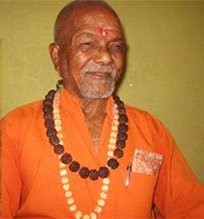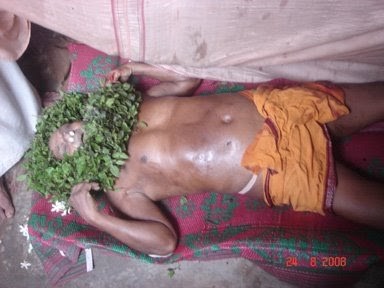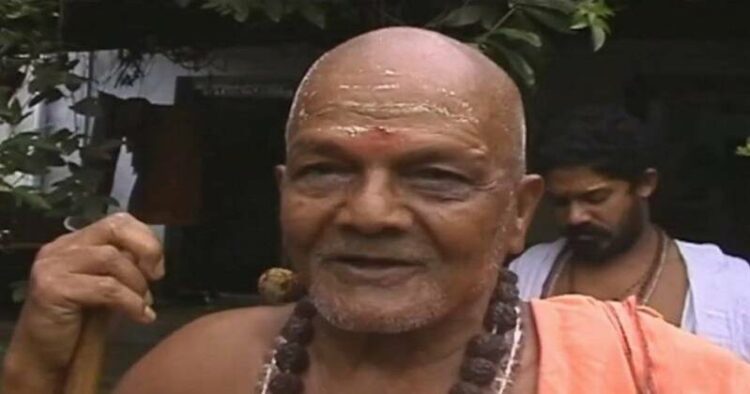Swami Lakshmanananda Sarswati

Born in 1924 in village Gurjung in the forest-dominated Phulbani (Kandhamal) district of Odisha, he had always aspired since childhood to dedicate his life for the society.
Despite being a householder and father of two children, one day he finally took the path to Himalayas for spiritual practices with the aim of fulfilling his resolve. In 1965, he returned and joined the Goraksha (Cow protection) movement.
Initially, he made Chakapad, a village in the forest-dominated Phulbani (Kandhamal) district, his place of work. In a few years, his service work started to resonate in the forest areas all around.

Besides social and religious development of the tribal people, he worked for four decades to empower them. He established a school based on Gurukul system and a college to teach Sanskrit in Chakapada, a remote place of Kandhamal.
Sankaracharya Kanyashram, a residential school at Jalespatta is another ashram of Swamiji in the district, where education is being imparted to girls.
In 1969 he started his first ashram at Chakapada and the ashram became a hub of activities aimed at the welfare of the local tribal population. He renovated the temples: Birupakshya, Kumareswar and Jogeswar .
Swamiji was well versed in Vedanta philosophy, Sanskrit grammar and hence was known as “VEDANTA KESARI”.
He stood firm in Phulbani district for a long time and struggled hard to preserve and protect the tribal culture and dharma, the Sankaracharya of Govardhan Pitha, Puri awarded him with the title of “BIDHARMI KUCHAKRA VIDARAN MAHARATHI.”
While he started his work in Kandhamal, a devoted RSS Pracharak, Sri Raghunath Sethi got associated with him for a long period. He initially selected his place of activities at Chakapad because it has famous Birupakhya temple. Subsequently he established Kanyashram at Jalespatta, a Seva school at Tulasipur, Banki in Cuttack district and an Ashram at Panigola in Angul district.
The Birupakshya temple at Chakapada is situated in the district of Kandhamal (Phulbani). It stands on an elevation of about 800ft. from sea level. River Burutanga is flowing near the temple. The place is surrounded by beautiful natural scenaries. Chakapada has also been mentioned in the Ramayana. The old age name of Chakapada is Ekachakranagari. The name is connected with Ramayana. Here exists a Shiva temple where Linga is bent to south and all the trees of the place are also bent to south.
Swamiji was a visionary. It has been clearly established by his activities as he took step by step and transformed the total life style of people of Kandhamal.
He had started night school for adult education. He stared a Sanskrit School named Kalyan Ashram, Sanskrit vidyalaya at Chakapad in the year 1969 which has now been elevated as a Sanskrit college.
For the education of the girls, he established ‘Sankaracharya Kanyashram’ a wholly residential school at Jalespata in Kandhamal, in the year 1988 where 250 girls’ students are studying. He also established a school at Banki and ashram at panigola in Angul district.
Swamiji taught grammar to the student in the class and technique of good cultivation in the field. He taught the villagers when and how to cultivate paddy vegetables etc. Due to his efforts, farmers at. Udaygira and Raikia blocks area produce the best quality and highest quantity of beans in Odisha. They also formed a vegetable cooperative society at Katingia. Through these efforts, the economic condition of the local population improved a lot.
Now we can see greenery everywhere in the Kandhmal because it has more forest cover than any other district. It is all due to Swamiji’s efforts.. He also established “Mutths” on the hill tops in several parts of the district and told the villagers that the trees in the hill belong to mutths and the village community. If emergency arises one can cut a tree and take wood only after the permission of the village committee. That worked tremendously. The joint forest management system which govt. started now had been started by Swamiji in 1970.
Swamiji was very committed to preservation and protection of tribal culture and tradition. He has established and renovated the tribal deity place (Dharanipenu) in several places. Similarly he had started a Rathyatra throughout the Gajapati and Kandhamal district during which thousands of tribal were motivated to go back and adhere to their own belief systems.
He often said that the area will not prosper where tear or blood falls. He was against the indiscriminate cow slaughter. He taught the people to protect cattle from being slaughtered. On several occasions he staged demonstration, dharnas and participated in the hunger strike in several parts of the state. He toured throughout the state for this cause.
He was associated with several socio-cultural and religious organizations. He has established and renovated several temples in different parts of the state.
His main work in Kandhalmal was protecting the tribals from Christian conversion. He tried his level best to bring back the tribals to their original faith. Inspired by his work, thousands of people in different parts of the states became his disciple.
His main mission was:
1. Making the tribal youth strong, fearless, educated and financially sound.
2. Tribals should be strong in their belief and check conversion of their brethren and reconvert those who have gone out.
3. Protection of cows
This made him popular thought out the state. During the two big functions at Chakapad in 1986 and 2007, lakhs of people gather in that remote place.
He undertook padyatras of villages across the district. He connected with many young men and women of that society and traveled from place to place.
Millions of people of Odisha have special reverence for Swami Laxmananand ji. He aroused a sense of self-respect in the lives of millions of forest dwellers by performing padyatras in hundreds of villages. He organized the Srimad Bhagwat Katha in hundreds of villages.
In 1986, Swamiji set up the deities of Lord Jagannath Swami, seated in Jagannathpuri, in a huge chariot, and travelled through the forest districts of Odisha for about three months. Through this chariot, about 10 lakh forest dwellers and women got connected with Lord Jagannath and worshiped reverently. Through this chariot, Swamiji created public awareness against prohibition, social evils and promoted cow protection. This awakened consciousness and devotion among the forest dwellers.
From 1970 to December 2007, Swami Ji was attacked 8 times. But in spite of these attacks, Swamiji’s resolve to stop conversions of forest dwellers into Christianity was unwavering. Swamiji used to say- “Whatever they try, they will not be able to obstruct the divine work.”
Preceding the Murder
- Between 10th to 21st Aug, 2008, Swamiji received 3 letters threatening of abduction and death.
- After many complaints to the police, the personal security staff was provided on 23rd August.
The Murder Sequences of Events
- On 23rd Aug 2008 at 7:30 PM at Kanya Ashram Jalespatta Kandharmal District of Orissa, Swamiji was interacting with inmates of Asharam after his Prayer.
- 15 young masked men, armed with AK47 rifles & other weapons entered the Ahram.
- Assuming Baba Amritanand as Swami Lakshmanananda Sarswati , he was shot.
- Mata Bhaktimayee another disciple from the ashram rushed out through back door , came to Swamiji’s room , shut the room’s door from inside, pushed Swamiji in to the toilet to save him .
- The attackers cut the door and hit Mata Bhakatimayee. Kishore Baba, who rushed for the help also got fired upon.
- Assailants entered the room and searched for Swamiji , not finding him any where , they cut open the toilet door and shot him.
- Swamiji died on the spot. He was 84 when he was brutally killed
- The attackers savagely hacked the bodies of the deceased with sharp weapons.

Reasons Behind the Murder
- Swamiji’s activities to check the illegal & fraud conversions by the Christian missionaries over a period of 40 years.
- Anti-cow slaughter campaign by the Swamiji
- Swamiji exposed the Christian land grabbers.
- His upliftment activities challenged Christian Missionaries who were trying to convert hapless tribals.
History of pervious attacks
- Swamiji was attacked 8 times before the final assault:-
– In 1969 by a mob of Christians led by priest of a local church at Rupagaon.
– In 1970 by cow traffickers
– In 1978 in Batingia in religious gathering.
– In 1981 by armed Christian terrorist at Khatingia.
– In 1983 by Christians in Kanbagiri.
– In 1999 by Christians in Firangia
– In 2002 in Kalinga , he was injured in the head.
– In 2007 he was attacked & injured while going to Bramanigaon.

Security Failure
- In spite of 8 attacks on Swamiji adequate security was not provided by the administration.
On the day of murder the lone security staff was allowed to go on leave without any substitute.


After the Murder
- 23rd Aug: Road block, protest demonstrations took place in several places. Curfew imposed in Jalespetta
- 24th Aug : People took out the bodies of Sadhus in a procession.
Government of Orissa ordered Judicial Enquiry. - 25th Aug: State wide Band was called.
Strong reactions were reported from several places.
Swamiji’s funeral procession was taken out in Chakrapada - 28th Aug: Christain educational institutions all over the country remained close protesting alleged atrocities in Khandhamal.
- Between 25th Aug to 1 Sept: Many Christians set their own houses on fire & shifted to churches.
- Indiscriminate arrest of large number of Hindus.
- Massive false & malicious campaign by the Christians
- Pope Benedict XVI issues a condemnation of the alleged killing of Christians in Khandhamal.
- 3rd Sept petition of a Bishop , Rafael Cheenath : The SC asks the State Government not allow any yatra.
- 5th Sept Police : arrested 453 innocent Hindus
- 6th Sept: Thousands of Sadhus gathered in Bhubneshwar & got arrested.
Issues behind the conflict in the Area :
- Reservation:Members of the Pano tribe have been converted to Christianity through force , inducement & fraudulent means and there was a campaign to give the converts reservation benefits.
- Land :Churches had grabbed large tracts of land belonging to other non-converted STs of the area.
- Cultural Onslaught : For conversion of tribles Christian Missionaries were trying to changes culture & beliefs of tribals but Swamiji was an obstacle in their activities.
Failure of Administration in Enforcing Orissa Freedom of Religion Act 1967
Failure of the Administration in Enforcing Cow Slaughter Prevention Act .
UPA Government Role in the Issue
- No statement on the killing of Swamiji by UPA government.
- In fact, the then PM Manmohan Singh & Congress Party issued statement in favor of Christians of Kandhamal.
- Union Minister of Home Affairs, Shivraj Patil visited Christian settlements & relief camps but did not bother to visit the Ashram.
- Both Central & State Government provided financial aid to the allegedly affected Christian families post incidents.
No efforts have been made by the government or administration to arrest the culprits (the Christian militants) and seize the illegal weapons kept by them. The roles of Christian NGOs was not investigated. The attitude of the government was to protect Christians and harass Hindus. Hundreds of Hindus were arrested but a very few Christians were interrogated. Lakhs of rupees were provided to the churches and other Christian organizations as relief, even though they weren’t damaged during that period.
Christian militants had brutally killed Swami Laxmananda Saraswati, Bhakti Mata, Amrutananda Baba, Kishore baba and Purub Ganthi a guardian of a Kanyashram girl on the occasion of celebrations of Shri Krsihna Janmastami on 23rd August 2008 at 8 pm. They even dared to enter to the kanyashram and brutally kill 5 persons.
Reference :
(Truth behind Swami Lakshmanananda Saraswati’s Murder:
A Book by Vishwa Sambad Kendra Bhubneshwar Orissa)




















Comments